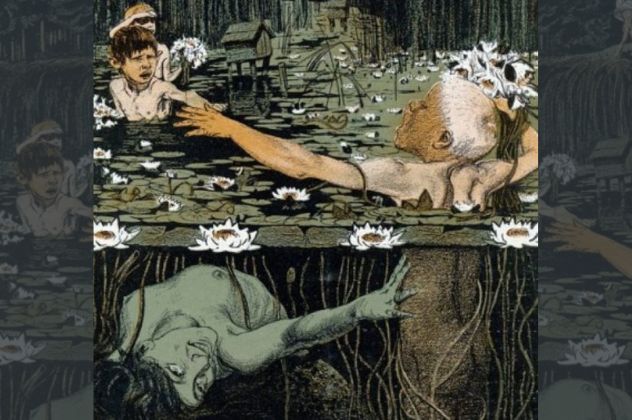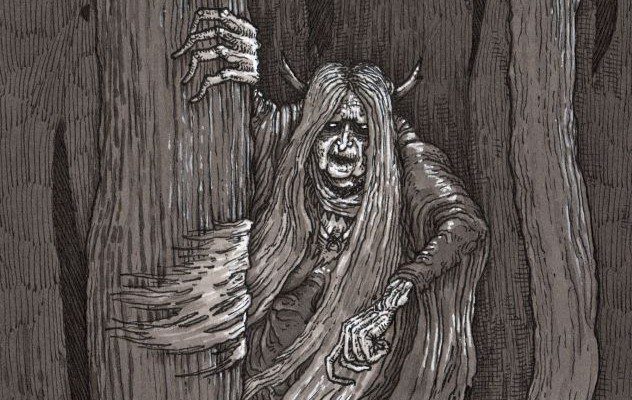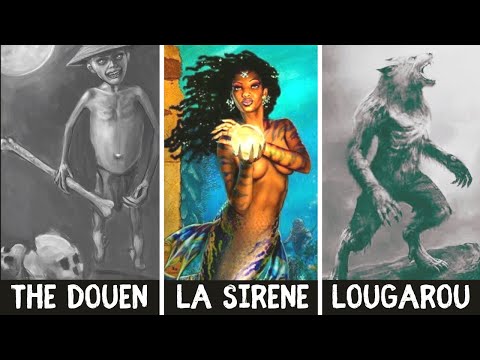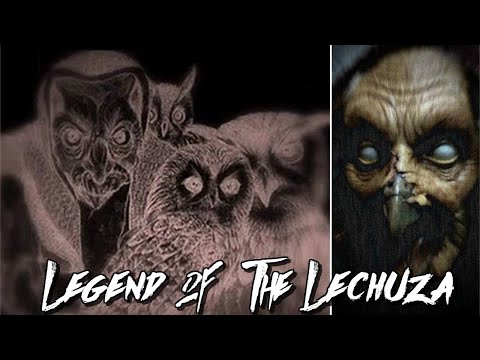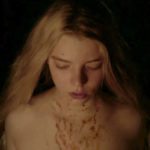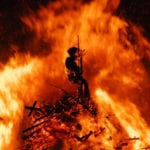Though it isn’t recommended that one uses this term to describe anyone magically adjacent nowadays, the original usage of hag describes figures who are more solitary, borderline creaturesque in appearance, and often with a penchant for murder and cannibalism. And this list will document ten of these sorts of witches. And unlike figures such as Hecate and Grendel’s Mother, the witches on this list come from more than mere pantheons and poems; these bogeymen were thought to be totally real. Do brush up on your Brothers Grimm before investigating them.
10 Nelly Longarms
Nelly Longarms is first on this list, in as much as she is a superb example of the archetypal witchy hag, or at least the English version. Originating near Durham, England, Nelly is often described as a withered, older woman with long sinewy arms and wild hair. This is likely because many folklorists believe that this sort of figure was originally derived from the worship of the crone or a particular deity associated with guidance, old age, and wisdom in many pre-Christian European pantheons. Over time, however, as these deities became more and more associated with their devilish traits, the more popular Christianity became. Nelly Longarms is no exception. This hag’s favorite pastime involved luring children to the water and dragging them to a watery grave. Nelly Longarms is a water spirit, and while that is not a prerequisite for this sort of mythological witch, it is a trait shared by many other hags. She is also known for making many odd sounds and magically appearing in village streets and doorways, attempting to lure the curious to their death by drowning.[1]
9 The Aswang
One of the archetypical hag’s most notorious character traits is her penchant for cannibalism, and what other monster shares this quirk more than the blood-sucking vampire? Originating from the Philippines, the Aswang is a bit of a witch/vampire hybrid, combining the deadliest behaviors of both beings. Watch this video on YouTube The aswang hunts its victims by night, shapeshifting into any animal, from the furtive, silent cat to expert hunters like the wolf. Though, once it finds its victims, it perches on top of their homes until nightfall, using an elongated, prehensile tongue to get a read on the home, much like a snake’s tongue, before burglarizing and cannibalizing. The Filipino legend can also curse its victims, its signature move involving rice, sand, and even bugs pouring out of its victims’ orifices.[2]
8 Muma Pădurii
Romania is where this next witch calls home. Though she still has a habit of attacking children, she is admittedly a tad bit more benevolent than other hags since she at least helps nurse the animals of the woodlands back to health with her assorted potions. With bulging eyes, withered hands, and a good bit of weight to her, Muma Pădurii also differs from the other hags because she can shapeshift between an old woman and an old man—though those are far from her only forms. She can also change into a beautiful young woman, a nun, and even a tree. Muma isn’t always cruel, though, only really choosing to enact her revenge on those who’d dare tear down her forest for her home. She even, from time to time, helps children lost in the woods back to their homes and also lacks the cannibal tendencies of other entries on this list. According to Romanian legend, she is also married to the legendary Father of the Forest.[3]
7 Jenny Greenteeth
Next on this list is the enigmatic Jenny Greenteeth, Nelly Longarm’s more famous and colorful folkloric counterpart. Jenny also differs from Nelly because she’s a bit less picky in her choice of victim, choosing to drown both children and elderly people instead of just children. She also has more than one hiding spot and can sometimes be seen lurking in the branches of willows and other swampland trees. Originating from the Lancashire area of England, this Hag is described as having green skin, long, disheveled black hair, and razor-sharp teeth. She is also claimed to have made her way over to North America, as superstitious sailors boating near Erie, Pennsylvania, claim to see her swimming Lake Erie.[4]
6 Soucouyant
This next legend can supposedly be found in the Caribbean nation of Trinidad and Tobago. Though the term describes a type of witch more than a single entity, the soucouyant certainly cements itself in the wicked witch canon by possessing the ability to magically transform into a fireball for transport, as well as a wicked thirst for mortal blood. The soucouyant can also be allegedly found as far west as Jamaica and as far north as Louisiana. Other tricks up this hag’s sleeves involve her shapeshifting ability to steal her victims’ skin if the blood loss results in death. And she can even fit through the tiniest holes, such as a lock or crack in the wall, in order to enter homes. There are ways to make a getaway, however, and it is claimed that if you place a bowl of rice in front of your door, she’ll count every grain before making an authentic pursuit.[5]
5 Yamauba
While technically, the Yamauba is a Yokai of Japanese legend, it has the exact appearance needed to compare it to the other entries on this list. When trying to blend in, this legend looks like any other woman in her seventies—unless you can spot her horns and fangs after a provocation. She is said to live in huts along the roadside, offering shelter to travelers without it. However, if you see her demonic attributes with your own eyes, she will attempt to devour you on sight. Unlike other entries on this list, Yamauba describes a number of yokai, as opposed to just one figure. Her origin story claims that this spirit appeared when a woman with less-than-historically appreciated habits wandered into the wilderness and developed more demonic attributes. It is also claimed that some families living in poverty abandoned their daughters to ease their burden and care more properly for the other family members. Then, these unfortunate girls would develop into the yokai after living alone for so long.[6]
4 Obayifo
This next entry is a particularly illuminating entity from Ashanti folklore of modern-day Ghana. And that choice of vernacular is a play on words because the Obayifo is said to have an uncontrollable glow coming from their armpits and anus. As a vampire-like mythological creature, Obayifo are very common and may inhabit the bodies of ordinary people. This is because, much like the Yamauba, the Obayifo is something you become after dabbling in the Ashanti form of witchcraft known as “Bayi.” What this particular witch-slash-vampire does is hunt hapless victims for their blood and life energy; they can even possess unsuspecting travelers, completely taking over their bodies. The Obayifo can also travel through the sky by transforming into a glowing ball of light and has a particular appetite for children, as well as the life energy of newly-growing crops. In fact, one core character trait of the Obayifo is that they are always, always hungry, no matter how much they eat.[7]
3 Black Annis
Described as having pale blue skin, sharp iron claws instead of fingers, and raven black hair, Black Annis is an enduring legendary hag, making her supposed home in the Dane Hills near Leicestershire, England. Much like Hansel and Gretal’s primary antagonist, this witch has the diabolical urge to feast on children and allegedly hunts any who carelessly wander through her domain, leaving their skins to tan on the tree branches above her cave-home. It is thought that Black Annis was a wicked fae and is even sometimes tied to the Celtic deity Anu, though it is tricky to pin down her exact origins. Black Annis also possesses the ability to roar an intensely loud roar that can supposedly be heard from even five miles away. You can tell she’s prowling your village, looking for babies to snatch from the window, by the incessant grinding of her teeth. In an attempt to drive her from her cave, the folk of Leicestershire led a “hunt” every Christmas, using a dead cat stuffed with aniseed to draw the witch from her cave to the home of the mayor, though no hunt ever successfully produced a blue-toned body.[8]
2 La Lechuza
While many of the witches on this list can be described with features often associated with old age, La Lechuza takes it a step further and dons a more avian approach. She’s described as a giant, seven-foot-tall owl with a fifteen-foot wingspan and an old crone’s face. This witch’s legend comes from Mexico, long before the Spanish explorers arrived. La Lechuza is an example of a bruja, or a traditional Mexican witch, though her Spanish name does directly translate into “The Owl.” La Lechuza’s modus operandi involves more of an origin story than other entries on this list, however. It was originally thought that “The Owl” was a woman convicted of practicing evil magic and was put to death via a witch trial. Unlike most witch trials, however, this figure came back as a massive owl, tricking unsuspecting passers-by with mimicry of babies crying or frightened women before swooping down and getting in a bit of vengeful murder herself. And unlike other witches on this list, people claim to witness La Lachuza swooping after them, even into the 21st century.[9]
1 Baba Yaga
Fans of Ant-Man have been waiting for this reference, and indeed, she is perhaps the most famous of wicked, wizened witches in the world. She is described as an old woman far larger than most people with an equally large nose and is often found working over her stove or lounging about her humble abode. She lives in a mobile hut that walks around on chicken legs, and she rides in the sky on a mortar, pushing herself along with a pestle as an oar. She is the Baba Yaga. Watch this video on YouTube One of the most prolific figures in Slavic folklore, Baba Yaga may have begun her legend as an Earth Mother Goddess in the region. Still, other scholars claim that she is instead related to the deity of the dead, Iagaia Baba. She is first mentioned by name, however, in the mid-18th century. While she often seeks children to stick in her stew, using geese for reconnaissance, she has occasionally played as a benefactor in a handful of stories. And she has, on occasion, impersonated Cinderella’s Fairy Godmother by helping free Vasilissa the Beautiful from a wicked stepmother.[10]
